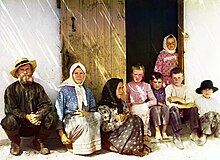Mughan plain

Mugan plain (Azeri: Muğan düzü, دشت مغان; Persian: دشت مغان, romanized: Dasht-i Mughān) is a plain in northwestern Iran and the southern part of the Republic of Azerbaijan. The highest density of irrigation canals is in the section of the Mugan plain which lies in the Republic of Azerbaijan. It is located on the bank of the Aras river extending to Iran.[1]
The Mugan plain consists of five cities: Bilehard, Parsabad, Jafarabad, Garmi and Aslandoz. One third of the plain is located in Iran and the rest is in Azerbaijan. From 1353 to 1372, Garmi was the center of this city. After that, Mugan was divided into three cities, Bilehayar, Garmi and Parsabad. The soil of this plain is very fertile.
Alikemek-Tepesi

The ancient settlement of Alikemek-Tepesi (Alikemektepesi), dating to c. 5000 BC, is located in the Mugan plain, and covers an area of over 1 hectare.[2] Early levels belonged to Shulaveri-Shomu culture.
See also
Notes
- ^ The Embassy of the Republic of Azerbaijan in Spain Archived 2007-09-29 at the Wayback Machine
- ^ Махмудов Ф.Р., Нариманов П.Г., 1974. Поселение Аликемек-тепеси. АО 1973 г. М. (Russian)
References
